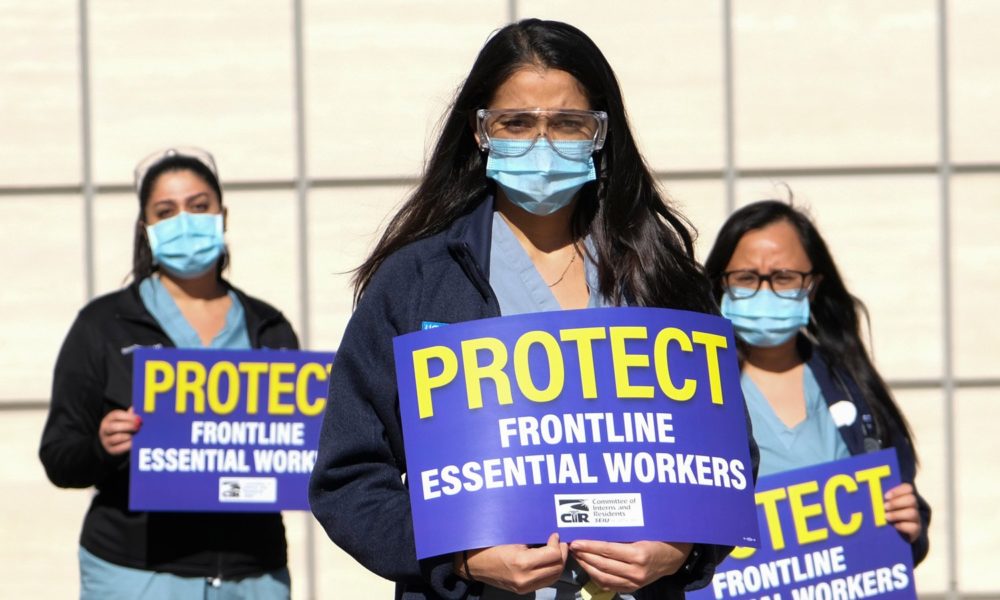Update (April 9, 2021): When we published this blog post, our expectation was that OSHA would be issuing a COVID-19 emergency temporary standard imminently. It has recently come to light, however, that Secretary of Labor Marty Walsh is purposefully delaying the release of the standard.
The emergency is not over. Data show that COVID-19 risks in the workplace remain very real and very dangerous for workers across the country, including nurses, bus drivers, meatpackers, farm workers, and so many more.
There is no more time for delay. With the latest science showing the spread of more transmissible variants and a surge in infection rates, it’s crucial that the Biden administration acts now to protect the nation’s workers, including food and farm workers and the many others who continue to face COVID-19 risks in their workplace.
Every person in the US should be entitled to a safe working environment. Yet even as the COVID-19 pandemic threatened tens of millions of essential workers over the past year, employers and government safety regulators made choices that endangered workers’ lives.
Workers desperately need basic health and safety protections from COVID-19, such as mandatory mask wearing, social distancing, and ability to quarantine when sick or exposed. Now new leaders at the federal Occupational Health and Safety Administration (OSHA) are on the verge of changing that.
It is widely expected that OSHA will issue an emergency temporary standard (ETS) for COVID-19 in the next few days. The ETS could mark a major shift in the way we protect workers at one of the most precarious moments of the pandemic. It also will provide needed worker protection in states that are actively ignoring public health experts by dissolving mask mandates and throwing open their entire economies.
Essential workers—such as grocery store workers, health care workers, bus drivers, delivery workers, and meat and poultry plant workers—are disproportionately people of color. Therefore, the upcoming OSHA ETS not only has the ability to save lives in all communities across the US, it also may be especially impactful in reducing deaths, hospitalizations, and other serious COVID-19 complications in communities of color, low-income communities, and Indigenous communities.
Why an emergency temporary standard is desperately needed
According to the Occupational Safety and Health Act of 1970, an ETS is a tool that OSHA can use when workers are in “grave danger” and need for OSHA to act for their immediate protection. An ETS would have the status of a formal regulation, meaning that it would be enforceable, and that OSHA and employers would be legally obligated to adhere to the ETS. A few states—Virginia, Michigan, Oregon, and California—have already developed an ETS to protect workers from COVID-19. Specifically, an ETS can be created to safeguard workers from “exposure to toxic substances, agents determined to be toxic or physically harmful, or to new hazards.”
COVID-19 undoubtedly fits this bill. The novel coronavirus’ nasty ability to spread via airborne transmission in indoor settings means that the virus can circulate rapidly through most workplaces. And that means—because employers have often resisted fully implementing COVID-19 safety protocols—essential workers have been catching this virus at the workplace, inadvertently bringing it home to their families, and their workplaces are later identified as the sources of major outbreaks in the surrounding communities. According to one study, this translates to 56 to 74 million US adults that are at an increased risk of severe COVID-19 symptoms because they or members of their households are essential workers who cannot work from home. Workers, their families, and their communities need and deserve strong, enforceable, and science-based OSHA protections.
For instance, workers in meat and poultry processing plants have been working under life-threatening situations during the pandemic, further exacerbating the health risks and inequities this group of workers faced even before COVID-19. The Food and Environment Reporting Network reported that, of the nearly 90,000 food and farm workers in the US who have tested positive for COVID-19, the vast majority (58,300) are workers at meat and poultry processing plants. There is an enormous racial disparity in these numbers—a CDC study found that 87 percent of the workers at meat and poultry processing plants who tested positive for COVID-19 were Black, Latinx, or Asian workers. Meat and poultry workers have been continually forced back to work in unsafe conditions during the pandemic via executive order, under pressure from employers such as Tyson Foods, or because of agency rulemaking. An OSHA ETS would go a long way in providing meat and poultry workers and other essential workers an enforceable and science-based set of protections against COVID-19.
The Biden administration vows to safeguard workers…
Since its first days, the Biden administration has signaled agreement on the need for a COVID-19 ETS. On January 21, President Biden issued an executive order that, among other things, required OSHA and its parent agency, the Department of Labor (DOL), to “consider whether any emergency temporary standards on COVID-19, including with respect to masks in the workplace, are necessary, and if such standards are determined to be necessary, issue them.”
At the moment, there is no rule or regulation that makes it mandatory for workplaces to follow CDC guidelines to protect workers from COVID-19. Under the Occupational Safety and Health Act of 1970, there is a “general duty clause” which authorizes enforcement actions for hazards that can cause “death or serious physical harm.” However, it is rarely used and is difficult to cite—from February to October 2020, COVID-19 general duty clause violations were only cited three times.
It is uncertain what the specifics of OSHA’s upcoming ETS will be, but generally we can predict that it will incorporate CDC recommendations and, in line with the Biden administration’s demonstrated priorities, mandate the use of masks in the workplace. It may codify parts of OSHA guidance that was issued in late January, which recommends actions like mask wearing, the use of personal protective equipment, physical distancing and the installation of physical barriers, improving ventilation, providing supplies for good hygiene, routine cleaning and disinfection, and instructing workers to isolate or quarantine if they are sick or exposed.
…Unlike the previous administration
Under the prior administration, OSHA and the DOL took a hands-off approach during the pandemic. During the Trump administration, the agencies were more likely to tell workers who were worried about catching COVID-19 that, unless they wanted to read some guidance recommendations, they were on their own.
DOL political officials used their authority to limit who qualified for joblessness assistance, made it easier for small businesses not to pay for family leave benefits, and ignored DOL career staff who wanted to mandate CDC recommendations—like mask wearing—to protect workers. OSHA told companies (not once, but twice) that they could in essence ignore the law and not report COVID-19 cases in certain circumstances.
These actions had consequences. One month ago, the Department of Labor’s Inspector General issued a report blasting OSHA’s conduct during the pandemic. From February to October 2020, OSHA received 15 percent more safety complaints, as compared to the same time frame in 2019, yet performed 50 percent less inspections. The inspector general also spotlighted OSHA’s refusal to issue an ETS during the pandemic, noting that OSHA’s unenforceable guidance measures did little for workers, and insisted that workers would be better protected from COVID-19 by an ETS for airborne infectious diseases.
Workers deserve a healthy and safe working environment
Workers are a fundamental part of our communities and they deserve strong health and safety protections. Labor unions and worker advocacy groups, including the Food Chain Workers Alliance, have been asking for such protections for a long time now. An OSHA ETS would provide a firm and enforceable set of mandates that companies must follow to protect its workers from this deadly disease.
It is heartening to see the Biden administration’s OSHA about to take a concrete step in using science to protect workers. But the urgency of the final implementation of the ETS cannot be overstated. Each day more people die or become infected with COVID-19, and therefore the Biden administration should issue this lifesaving ETS as soon as possible. With workers better protected, this ETS will help slow the spread of this disease and help the entire nation get one step closer to ending this pandemic.

